Menu
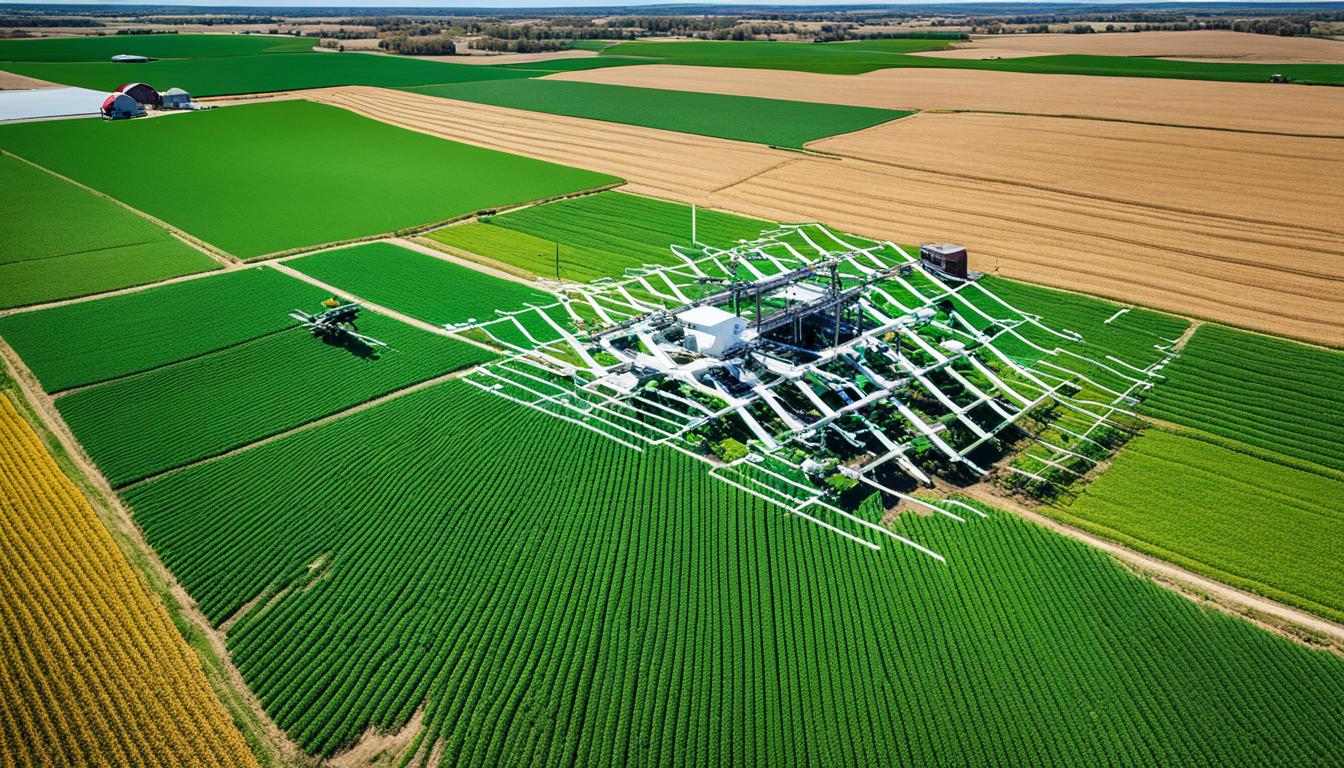
Do you know that in India, agriculture is huge? It makes up about 18 percent of the country’s money making, and nearly 65 percent of people are working in it. This shows how important farming is there. Technology in farming, from precision agriculture to fancy robots, is making big changes. It’s boosting profits, making things run better, and helping the environment.
Adding technology to farming is a big deal. Things like smart sensors for checking the weather or ground, flying drones for taking pictures, and GPS for getting around easily are now key for dealing with farm problems. These tools help farms use less, do things more precisely, and keep workers safe. This all helps the planet too.
Technology is making how we use resources better, food safer, and the earth healthier. Using AI in farming is slowly changing the game. It’s making farming really accurate and using data to make the best choices.
To sum up, mixing technology with farming is leading to a new way of getting ready for bad farm situations. It’s not only protecting the land but also the people who work the fields.
Being ready for emergencies is key in farming. It means having a plan to deal with sudden crises well. Today, farm tech and quick emergency responses are very important. They help farms bounce back fast from tough times.
Farm emergency preparedness is all about having the right plans and tools to face sudden challenges. It’s not just about having a plan. It’s about using technology to make our responses quicker and better. This way, farmers can deal with tough times and keep the farm going strong, using digital solutions.
Tractor rollovers are often deadly accidents on farms in Pennsylvania. This tells us preparing for emergencies is crucial. It reminds us to always be careful around farm machinery and keep safety top of mind.
Ready to face emergencies, farming has come a long way. We started with basic, manual methods but now use cutting-edge tech. This change has made it much easier to deal with and even prevent crises.
For example, grain silos can trap dangerous gases. But with new sensors, we can know if it’s safe. And by setting up strict rules for biosecurity, we keep our farms healthy and productive.
Knowing what to do and having a solid plan is crucial to dealing with natural disasters. It shows why we need to have fire safety rules and learn what to do in emergencies.
The use of technology in farming changes how we work, making us more productive and efficient. It introduces new tools like digital aids for farming emergencies and systems to manage farm crises. This tech has transformed how we run our farms.
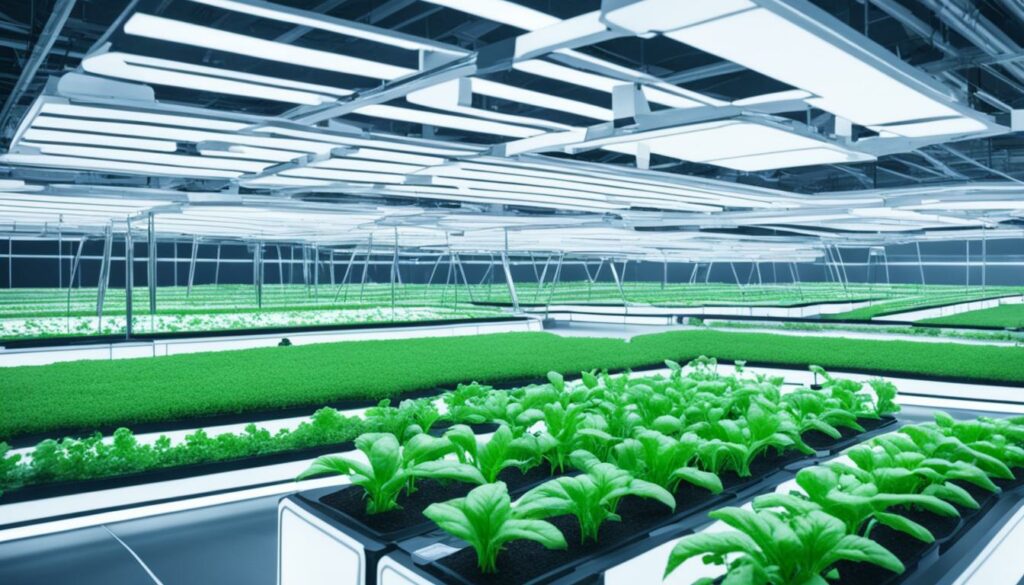
Thanks to tech, farmers see big improvements in their work. Applications like Granular help with making budgets and managing workers online. iFormBuilder lets field teams share data instantly using their smartphones. This makes farming operations smoother.
AG tech that works on laptops and phones makes things even easier and more accessible.
Using technology in farming has big environmental pluses. E-Agriculture gives us tools for keeping an eye on animal health and using GPS to farm smartly. For places like California, where water is short, we have wireless sensors that help save water. This tech also lowers chemical waste, helping the environment.
Tech makes farms safer for workers too. It offers solutions for emergencies and keeps track of where cattle and crops go. There are apps for keeping detailed livestock records, making the work less risky. This makes the farm a safer place for everyone working there.
Farmers rely on tech companies to link their systems and keep everyone on the farm safe and productive. Chetu is one such company, providing the latest in agricultural tech software. This keeps farms running smoothly, safely, and in an eco-friendly way.
| Technological Tool | Functions |
|---|---|
| Granular | Cloud applications for budget creation, operational schedules, workforce management, and analytics |
| iFormBuilder | Real-time data collection using smartphones |
| RFID Technology | Tracking cattle and crop shipments for security purposes |
| E-Agriculture | Precision farming tools including sensors for livestock monitoring and GPS technology |
| Wireless Water Sensors | Assistance in water conservation, particularly in drought-prone areas |
When it comes to preparing for farm emergencies, technology plays a major role. It includes real-time monitoring systems, automation, and predictive analytics powered by AI. These tools are changing how we handle crises in farming. They give farmers important instruments to reduce risks and react quickly to dangers.
Real-time monitoring for farm safety is now crucial. It combines satellite images with data from crops, soil, and water. This mix alerts farmers when there’s a risk, making it possible to act fast. This can help prevent damage from droughts, pests, and diseases. Cutting-edge technologies like minichromosomal tools also speed up approval for new plant traits. This helps innovative solutions get to fields sooner.
Automation in farming is on the rise to make work easier and more accurate. It uses robots and advanced machinery for tasks like planting and harvesting. This approach saves time and resources. Vertical farming is a good example. It grows crops in stacked layers, making efficient use of space. This can even work in cities or areas where farming is tough.
Predictive analytics give farmers insights before problems happen. With AI, they can anticipate weather and pest issues. This helps crops be more resilient. In 2014 and 2015, millions were invested in farming technology. This shows how much the sector is focusing on new solutions.
The World Food Programme (WFP) is using self-driving tech to help in East Africa. It’s working with others to enhance teamwork during emergencies, like in Ukraine.
| Innovation | Impact |
|---|---|
| Real-time Monitoring | Timely alerts mitigate risks |
| Automation and Robotics | Optimised operations and resource conservation |
| Predictive Analytics and AI | Enhanced foresight and crop resilience |
Farm emergency technology is essential, not just a nice-to-have. By using tools like real-time monitoring, automation, and analytics, we’re making farming more resilient.
Did you know precision agriculture is changing farm management? It’s improving our readiness for emergencies. With tech like mobile tools, smart maps, sensors, and AI robots, farmers are boosting their yields. They are also managing their resources better. We’re going to look at how these tech tools help in agricultural crises.
Here’s the scoop on precision farming. It brings lots of pluses for both normal and tough times. Drones keep a close eye on crops and animals, reducing the need for chemicals and physical work. This helps keep workers safe. They also let you know if something is off with the farm and its environment before it gets bad.
Wearable tech, like smartwatches, helmets, and vests, play a big role, too. They check your health and keep track of what’s going on around you. This prevents sickness from working too hard or in hot places.
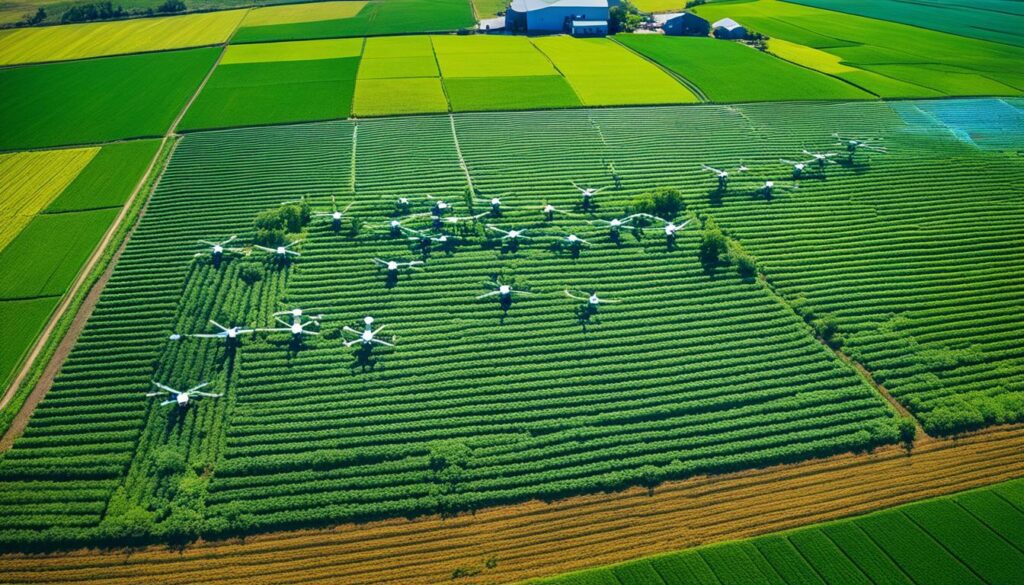
Precision agriculture is full of high-tech ways to handle crises. Imagine remote sensors spotting gas leaks or fires early on. They can warn you right on your phone or computer. This quick reaction can save lives and fields.
GPS systems that help find folks fast in accidents or floods are a must. They make sure help is on the way. Plus, there are smart tools that look at old data and today’s weather to guess what problems might pop up. This helps farms get ready for anything.
Looking ahead, these smart farming solutions are key to feeding the world by 2050. They offer exact ways to use resources, look after the soil, and water the land smartly. This keeps farms ready if a surprise hits.
Tony Kaplan, CEO of the International Crop Research Institute, says: “Technology in emergency planning makes a big difference. It boosts our farm safety and keeps the land healthy for the future.”
Here’s a table to show what’s great about using precision agriculture in a crunch:
| Feature | Benefit |
|---|---|
| Drones | Reduces chemical and physical exposures; saves lives |
| Wearable Technology | Monitors vital signs and environmental conditions; prevents heat-related illnesses |
| Remote Sensors | Detects gas leaks, fires, environmental changes; provides early warnings |
| GPS-enabled Systems | Quickly locates individuals in emergencies; ensures prompt help |
| Predictive Analytics | Analyses data to predict risks; implements proactive safety measures |
Biotechnology is showing its importance in agriculture when crises happen. It’s helping farming withstand problems we didn’t see coming. This shows how useful biotechnology is in agricultural emergencies.
Biotechnology is leading to stronger plants that fight off harsh weather, pests, and diseases. With genetically modified seeds, farmers can grow crops that are more resilient. This helps in climate change and food shortage situations. For instance, harsh diseases like the H7N9 flu highlight the need for disease-resistant crops.
Biotechnology isn’t just about crops. It also helps make livestock healthier and more productive. Thanks to DNA testing and special vaccines, animals are less likely to catch diseases. This makes them and us safer from health scares like the H1N1 swine flu and potential bioterrorism attacks incorporating dangerous pathogens.
Let’s look at the real impact of biotechnology with recent data:
| Outbreak | Cases Reported | Deaths | Mortality Rate (%) |
|---|---|---|---|
| SARS (2003) | 5327 | 349 | 6.6 |
| H7N9 Influenza (2013) | 469 | 182 | 38.9 |
| H1N1 Swine Flu | 128,033 | 805 | 0.63 |
| Ebola (2014) | 280,005 | 11,287 | 40.3 |
Sensor technology in agriculture helps us monitor farms better. It works well with IoT devices for proactive farm management. This approach helps predict and avoid emergencies by using accurate data and instant insights.
Sensor tools in farming have started a new phase of accurate farming. They measure things like soil moisture, nutrients, and plant health. These details improve crop growing and help plants when they need care the most.
John Deere shows how IoT devices aid in farm monitoring. They use these devices in their machines to perfect planting and caring schedules. This boosts how well farms run and raises productivity.

Farming wisely needs climate data to understand and predict weather for its crops. IoT devices give real-time weather reports and trends. They help farmers make smart choices. The market for these tools is growing fast, set to hit $13 billion by 2026.
These devices do more than watch the weather; they help in making plans and taking quick actions. This is crucial in places with harsh weather, helping keep crops and farms healthy and working well.
Overall, sensors and IoT are changing farming significantly. They point to a future with smarter, more sustainable, and resilient farms. These farms are ready for any surprise nature throws at them.
The importance of digital tools in farming emergencies has never been clearer. They help farmers access important data fast. This is crucial during crises. Without these technologies, quick and effective responses would be very difficult.
Mobile apps have changed how farmers deal with emergencies. They give farmers immediate updates and information. This allows for fast, smart decisions.
FarmLogs and Agrivi are examples of platforms offering many features. They provide everything from weather forecasts to detailed crop monitoring. Such tools are vital for dealing with the effects of emergencies on farms.
Health issues like contaminated water and animal threats are also addressed fast. These apps often share health warnings and emergency contacts. They even provide mental health support and connect farmers with others in the agricultural community after disasters.
Managing data from far away is also key in farming emergencies. The ability to watch over and control things without being on site is very helpful. Tools like Climate FieldView and John Deere Operations Center show how this can be done.
This is especially important in rural areas with limited resources. Being able to handle things from a distance helps keep food supply chains going. It also reduces the impact on the farm’s productivity. Protecting the environment through data and analysis is crucial for future resilience.
Big data is changing how we manage farm crises. It gathers information from many sources. This data helps us make better decisions quickly.

Abe (2017) noted a rising interest in leveraging data science for managing food, energy, and water resources, which is pivotal in farm crisis management.
Big data in farming is boosting on-farm yield. This method, called precision agriculture, uses predictive models and huge amounts of data. It can increase profits by as much as $100 per acre.
GPS sensors are also making food safer by cutting down on food poisoning cases. In the US, these tools might prevent 76 million cases a year. Using big data for finding supply chain issues also improves how we guarantee food security.
Government groups like the USDA, NOAA, and NASA share satellite data. This data helps with many farming tasks. It supports emergency planning too.
| Aspect | Data Application | Outcome |
|---|---|---|
| Satellite Imagery | Crop Monitoring | Improved yield predictions |
| Predictive Modelling | Farm Management | Increased profits up to $100 per acre |
| GPS-Enabled Sensors | Food Safety | Reduced food-borne illness cases |
| Spatial Data Mining | Supply Chain | Enhanced security |
| Meteorological Data | Weather Predictions | Better emergency preparedness |
Research is finding new ways to use technology in farming. For example, mobile systems now help spot plant diseases with deep learning. These advancements are crucial for managing emergencies well.
Experts also stress the importance of preparing for climate change. Their work shows how critical data management is during emergencies.
Finally, integrating research findings into practical tools is key. This helps turn the idea of using big data into real solutions for managing farm crises effectively.
Artificial intelligence, or AI, is key in making farm plans that prepare for the unexpected. Through AI, farmers can guess what might go wrong and prepare better to avoid risks. This technology is a big help in keeping crops healthy and boosting the harvest despite any emergencies.
In the 1970s, the SANBAR model changed how we deal with cyclones. Since then, our storm predictions have vastly improved, thanks to organisations such as the National Oceanic and Atmospheric Administration. Now, with AI and ML becoming more available, anyone can use smart models to be ready for disasters without spending a lot.
AI and ML can do a lot in disaster planning. They look at many factors to make better predictions than before. For example, Bayer uses AI to improve plant breeding outcomes quickly and accurately. This means better and faster ways to grow crops.
Bayer’s FieldView system is another example of AI making farming smarter. It uses many data sources to help farmers see risks more clearly. This leads to better decision-making on the farm.
AI isn’t just for big problems – it can help with small issues too. It can look out for pests in crops early on, which means less need for harmful pesticides. Apps like Tumaini and FarmVibes.AI help with this, as well as predicting soil and market trends. This helps farmers use resources more wisely.
In the end, AI improves how we deal with farm emergencies. It combines human knowledge with advanced tech to face challenges. This teamwork keeps us ahead in managing and preventing crises.
As farming evolves, GPS technology in farm crisis management and drones for agricultural surveillance play big roles. They bring high accuracy, efficiency, and quick data to farming. This helps deal with problems fast.
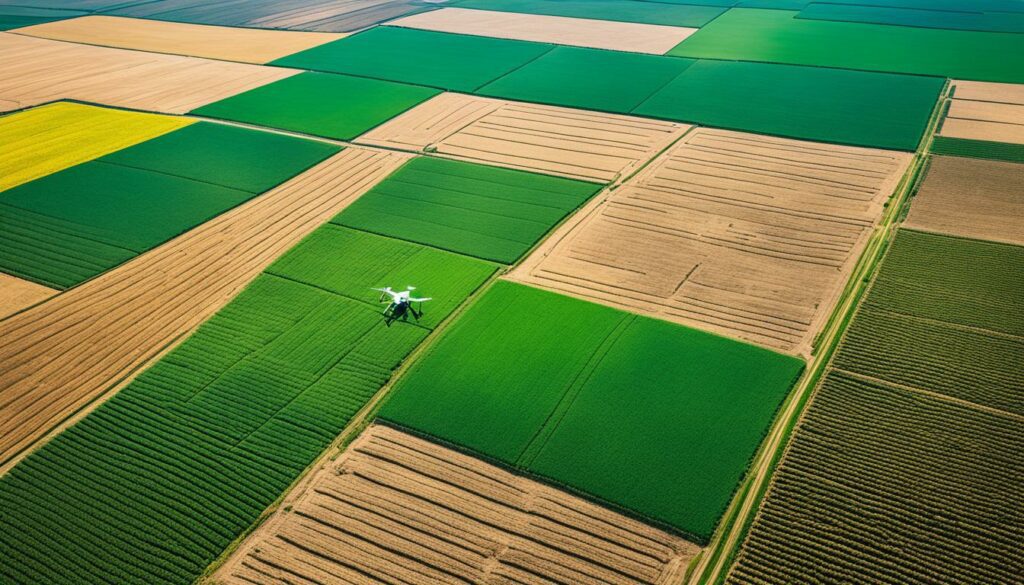
Drones in farming keep getting better. The market for drones is growing, now at US$32.4 billion. Drones can map large areas quickly, with clear images, which is great for big farms in a rush. They often give more accurate and detailed images than ground methods, even in bad weather.
Drones are a gamechanger for drones for agricultural surveillance. They make it safer to survey big or dangerous fields and can collect data on the spot. This quick data is key in emergencies, helping to use resources well and react fast.
GPS technology is also vital in farming crises. It gives exact positions, helping to make detailed maps and organised emergency responses. These tools are becoming very important, with the global precision farming market expected to hit $43.4 billion by 2025.
| Technology | Benefits |
|---|---|
| GPS | Precise location data, improved mapping, efficient resource allocation |
| Drones | High-resolution imagery, safer surveying methods, real-time data collection |
With climate change threatening the farming industry, these tools are more important than ever. European farming could face a 16% loss by 2050. It’s crucial to manage land wisely and use GPS and drones to fight back and stay strong.
Using technology for farm disaster preparedness is key to improving how agriculture copes with unexpected events. Advanced tech such as GPS systems for emergencies and smart devices are vital. These tools help keep farmers and their farms safe. For example, GPS systems can find people quickly in a crisis, cutting down on response times and maybe saving lives.
More than half of farmers above 50 suffer hearing loss from loud farm noises. To help, the NIOSH Sound Level Meter App tracks noise levels and tells when to wear ear protection. Farming safety apps like these protect the health of farm workers.
Smart devices like watches, helmets, and vests check your health and the weather as you work. They are key to preventing heat sickness and keeping farmers safe. Using tech in farming is not just helpful; it’s vital for facing unexpected challenges.
Automatic sensors on farms spot dangers early. They can warn farmers about gas leaks, fires, or big changes in the farm’s environment. Getting fast alerts helps farmers act quickly to stop disasters.
Also, there are tools that predict farm risks with data analysis. They use past records and current weather to guess future dangers. This way, farmers can work on problems before they become serious.
| Technology | Function | Benefit |
|---|---|---|
| GPS-enabled emergency response systems | Locate individuals quickly during emergencies | Reduced response times, potentially saving lives |
| NIOSH Sound Level Meter App | Measure noise levels and advise hearing protection | Prevent hearing damage, ensure health standards |
| Wearable technology | Monitor vital signs and environmental conditions in real-time | Prevent heat-related illnesses, enhance worker safety |
| Remote sensors | Detect gas leaks, fires, and environmental changes | Provide early warnings for proactive action |
| Predictive analytics tools | Analyse data to predict risks | Enable proactive measures, enhance preparedness |
Natural disasters like flooding, hurricanes, and wildfires happen more often now. To be ready, farms are using technology more. Looking at how tech helps in farm emergencies shows us good ideas and what works well.
In 2019 in Nebraska, a big flood happened. Farmers used high-tech tools like soil sensors and automatic irrigation to save crops. This tech let the soil heal fast and kept farmers from losing a lot of money.
In Northern California during the August Complex wildfire, drones and GPS were key. Drones watched the fire in real-time, helping move animals and stop the fire’s spread. GPS made planning for help easy in rural areas, making it faster to get to safety.
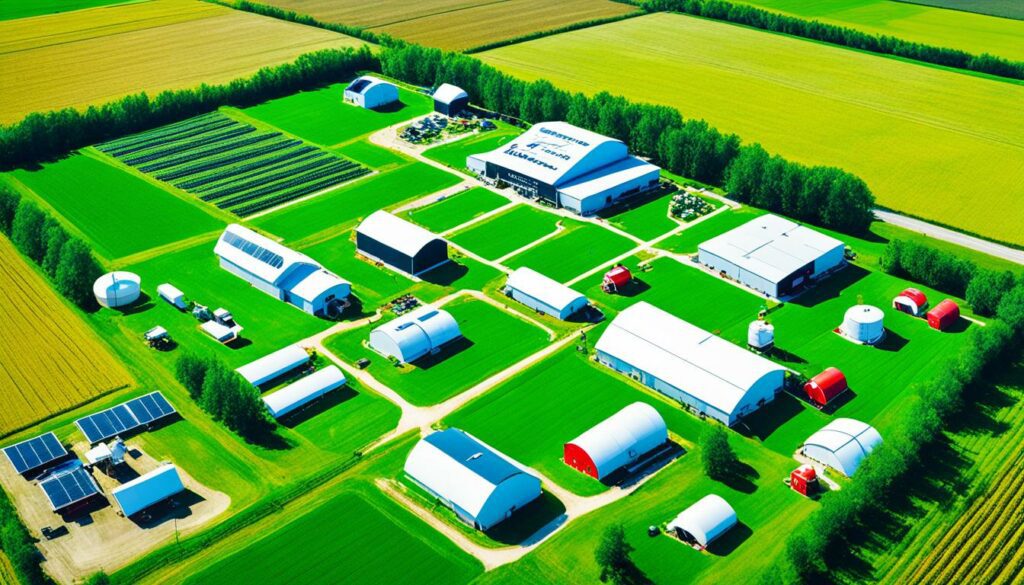
These stories teach us important things. Using smart tech to prepare for emergencies is really crucial. It helps to plan for and deal with disasters better and faster. Knowing the area well and working with the community are also key.
After a disaster, taking care of people’s mental health is very important. Using tech for remote therapy helps a lot. Lastly, investing in tech keeps farms safer during crises and for the challenges of the future.
These examples show how being ready with tech can save crops and lives from nature’s worst. Relying on new technologies is a great way to face emergency situations in farming.
Using the latest technologies in farm emergencies can greatly reduce risks. It also improves how well farms bounce back from tough times. But, there are many hurdles that stop farms from using these tech tools. Overcoming these barriers is key to reaping their benefits fully.
The cost of new technology is a big issue for many farms. Smaller farms often can’t afford these advanced tools. In the UK, farming, forestry, and horticulture face about £190 million each year in injury costs. So, it’s clear we need cheaper ways to stay safe.
Joining new tech with old systems is not easy either. It often needs a lot of technical know-how. Farmers are also more at risk of health problems. For example, they are twice as likely to get asthma because of work chemicals. Even with better machines, injuries can still happen. More than half of these are due to missing or faulty safety shields on machinery.
The agriculture tech trends of tomorrow are exciting. They promise to solve many of today’s challenges. With IoT and AI, farms will work smarter. PPE is also getting a high-tech upgrade. Smart gear can monitor health and call for help if needed.
Plus, there are new safety systems that use GPS to keep an eye on workers. These tools give real-time health and safety updates. This means better protection for everyone working on the farm.
In Wales, we see great progress with safety partnerships. Groups like ‘The Wales Farm Safety Partnership’ and ‘Growing Safer Farmers’ are leading the way. They share safety tips and offer support to make farms safer. Moving ahead, there’s a big push for advanced biotechnology. This tech could make crops and animals tougher, helping to face climate changes and diseases head-on. Zoonotic diseases, like ones that can pass from animals to humans, are a big concern. They affect around 20,000 people a year just in the UK.
| Challenge | Details |
|---|---|
| Accessibility | High costs limit smaller farms’ ability to adopt tech solutions. |
| Integration | Complexity in merging new tech with existing systems. |
| Health Risks | Farmers face double the national average risk for asthma. |
| Machinery Injuries | Issues with PTO shafts and machinery safety. |
Even though there are challenges, the future of agriculture tech looks bright. This new tech will help more farms be safer and stronger. Digital solutions, biotech advances, and smart gear are the way forward. With these, the agriculture industry is set for a safer and greener future.
The use of technology in farm emergencies has greatly changed how we deal with natural disasters. With climate change, extreme weather happens more often and is stronger. Events like floods, hurricanes, wildfires, and droughts can be tackled better with modern tech in farming.
These tools include real-time monitoring and prediction systems. They also have sensors and new ways to use biology. They give farmers the strength to deal with emergencies effectively.
Using technology in farming has many benefits. It makes work more productive and efficient, helping agriculture be sustainable. It also helps with health issues like carbon monoxide and mold during disasters.
AI and big data are used to predict the weather better. They help plan ahead, so farmers can face challenges quickly. This makes a big difference in handling natural disasters.
However, there are problems to overcome, like money issues and weak infrastructure in rural areas. But, both the farm and tech worlds are working hard together. They are finding ways to move forward.
Events like the flood in Nebraska and the wildfire in Northern California show this. They show how important it is for people to work together. With new ideas and teamwork, we are building a strong plan. This plan will help the farm sector face and overcome problems caused by disasters.
Technology is vital for emergencies on the farm. It offers new tools for watching in real time, collecting data, and managing crises well. This includes high-tech farming, cutting-edge robots, smart analysis, and special sensors. Together, these make farming more ready and responsive.
Farm emergency preparedness means getting ready for sudden farm challenges. It matters a lot to keep farms running well in tough times like bad weather or sudden pests. Using new tech is key for getting better at handling these tough situations.
In the past, farms used only traditional ways to prepare for emergencies. But now they mix old methods with advanced tech. This change helps farms be more sustainable, productive, and earth-friendly. It’s made handling crises a lot better.
Tech boosts how much we can grow and how well. It helps use water, nutrients, and pesticides exactly where they’re needed. This cuts down on waste and ups the farm’s profits.
Tech in farming is good for the planet. It reduces harmful chemical run-off and works to protect the environment. Tools like sensors and smart systems help farmers make eco-friendly choices.
New technology means less danger for those working on the farm. Robots and machines do risky jobs instead of people. Plus, devices that keep an eye from afar help out in emergencies.
Real-time monitors track the soil, weather, and animal health. They let farmers know quickly if something’s wrong. This fast info means quick, smart choices, helping to avoid bigger problems.
Robots and machines help in normal times and emergencies. They can keep the farm running when it’s hard for people to work. This way, farms stay efficient, even when things are tough.
Analyzing data and using AI can predict farm crises. These tools help farmers prepare for bad weather, pests, or diseases. Acting early makes farms stronger against emergencies.
Precision farming helps farms get ready for the worst. It makes using resources just right, keeping the soil and water healthy. This protects the farm against sudden hardships.
Biotech has made crops stronger against stressful conditions. With it, farms can still grow food even in harsh times. These advances have really lessened the effects of bad weather or pests.
Smart sensors and IoT devices give up-to-the-minute information on the fields and animals. This data helps farmers make choices that avoid or lessen emergencies. It’s all about being forward-thinking with how you manage your farm.
Apps and digital tech let farmers get key info quickly, no matter where they are. This helps manage the farm even when things are going wrong. Being able to take fast actions can prevent big losses.
Big data makes dealing with farm emergencies smarter and faster. It turns lots of information into clear, helpful plans. Planning ahead and using resources wisely makes big differences in tough times.
AI can forecast emergencies like bad weather or bug invasions. Its predictions help farmers get ready, making their plans more effective. This makes farms better at facing sudden challenges.
GPS and drones help by getting detailed views from the sky. They provide fast and clear information which is crucial in emergency situations. This information is used to respond quickly and efficiently.
Some farms have used smart technology and smart breeding to overcome emergencies. These stories show how tech can save the day and make farms more resilient. They provide great insights on how to handle crises effectively.
Cost and access can make it hard for farms to use emergency tech. But, tech trends suggest these obstacles will be overcome. Soon, farms will find it easier to use advanced tech, making them stronger against emergencies.